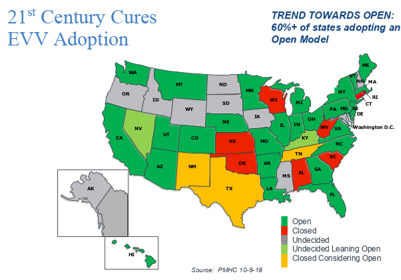Agencies can’t afford to delay. The regulatory deadline is approaching quickly, and the cost of inaction is high.
Our guidance to agencies - start now to take advantage of immediate ROI. We recommend that agencies in open states get started, in order to design an optimal workflow and allow time for implementation and testing. There are two parts to EVV compliance:
- Collect the right EVV data, in the right format. Use EVV to benefit your agency, it’s caregivers, and the patients you serve.
- Transmit EVV data to states and MCOs who mandate it, in real-time. Be compliant so your agency gets claims paid quickly, with lower audit risk.
Agencies can get started collecting compliant EVV data, so they are prepared to transmit that data when the state details their reporting requirements. By using EVV now, agencies can begin to improve productivity, reduce costs, and improve the effectiveness of care. The latest GPS technology provides automated visibility into the services delivered, as well as added safety for caregivers in the field. By embracing EVV technology over the next 18 months, agencies will be well prepared to meet the challenges and opportunities ahead.
States are moving ahead as planned
Ohio: On July 30, 2018, the President signed legislation giving state Medicaid programs more time to comply with Electronic Visit Verification (EVV) requirements by delaying fines that states would pay, until January 01, 2020. The Ohio Department of Medicaid (ODM) would like to clarify that this is not impacting Ohio’s EVV program and does not change ODM’s expectations that providers use the EVV system.
Ohio Department of Medicaid plans to match claims to visit data in the EVV system beginning February 13, 2019. All providers must have visit information in the aggregator at this time in order to ensure payment of claims. LEARN MORE.
CellTrak is an Approved Alternate EVV Vendor in Ohio
Florida: Effective October 1, 2018, fee-for-service private duty nursing (PDN), home health visits (HH) and personal care service (PCS) providers across the state must submit claims for home health services rendered through the AHCA EVV claims system. LEARN MORE.
CellTrak is interoperable with AHCA’s claim system in Florida
Colorado: The Department is still scheduled to implement the Sandata Santrax solution January 1, 2019. Implementing the system as scheduled will allow additional time for EVV users to pilot the new solution before the mandate is effective January 1, 2020. The Department is working on a delayed EVV timeline and will inform stakeholders of details over the next four to six weeks. It is the Department’s intention to use extra time to continue stakeholder engagement, extend the pilot program, and implement a soft roll-out. LEARN MORE.
Pennsylvania: Pennsylvania has adopted an open EVV model, where providers may choose the system that works best for them. The tentative plan for Pennsylvania’s implementation of EVV is:
- January 2019- PA guidance will be distributed
- Spring 2019- provider training will be offered with phased in system use
- Summer 2019 – full implementation of system. LEARN MORE
Update from Centers for Medicaid and CHIP Services
CMS will be hosting a national call on Wednesday, November 7, 2018 from 1-3pm ET to solicit stakeholder feedback on Electronic Visit Verification (EVV) implementation. During the call, CMS will address information submitted in advance through the previously established EVV mailbox (EVV@cms.hhs.gov) and will provide an opportunity for individuals to offer additional feedback at that time as well. As such, CMS encourages stakeholders to submit feedback to EVV@cms.hhs.gov by October 26, 2018. *Please include “November 7 Stakeholder Call Feedback” in the subject line of the email. LEARN MORE
